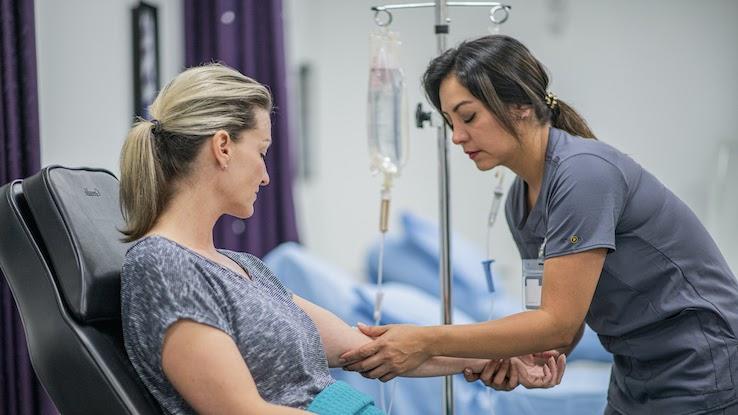How Do You Know if Aspirin Is Affecting Your Stomach

Stomach cancer, also known as gastric cancer, is a fairly uncommon form of cancer in the The states, accounting for 1.5% of all cancers diagnosed each yr. This disease primarily affects people higher up the age of 65 years old and is more common in men than in women. Over the past decade, the rate of new stomach cancer cases in the United States has dropped by just over a percent per year.
Experts suggest this may exist due to improvements in food storage and diet choices, along with a refuse in the occurrence of certain gastrointestinal bacteria that are commonly associated with stomach cancer. Learning about tum cancer and its chance factors, symptoms, handling options and more can help you become more proactive about managing your health or better set for intendance if you or a loved ane receive a diagnosis.
What Is Stomach Cancer?
Tummy cancer originates and develops in your stomach. There are several different parts of your stomach, and this type of cancer may occur in one or more of these sections. Additionally, dissimilar symptoms and outcomes tin develop with breadbasket cancer, depending on the department or sections of your breadbasket where it develops.
There are 4 master subtypes of stomach cancer:
- Adenocarcinoma. This type of stomach cancer develops in cells that are located in the innermost lining of your stomach, which is known as the mucosa. Co-ordinate to the American Cancer Social club, about 90 to 95% of cancerous stomach tumors are adenocarcinomas.
- Lymphoma. This type of breadbasket cancer develops in immune cells located in the wall of your tummy. These cells are known as lymphocytes.
- Carcinoid tumors. This type of stomach cancer begins in your tummy's endocrine, or hormone-producing, cells. Different another types of stomach tumors, carcinoid tumors typically don't spread to other organs.
- Gastrointestinal stromal tumors. These are the rarest types of stomach tumors. Gastrointestinal stromal tumors start in the nervous system cells located in the wall of your tum. They may develop in whatever role of your gastrointestinal tract, only well-nigh occur in the stomach.
Signs, Symptoms and Stages of Stomach Cancer

Cancer symptoms are often nonspecific, meaning you can attribute them to other wellness weather that also cause them. However, if you feel whatsoever of the following symptoms regularly, you should contact your principal care doctor for further evaluation. Some fundamental symptoms of stomach cancer include:
- Abdominal pain
- A feeling of fullness in the tum area
- Dark stool
- Nausea
- Airsickness, specially bloody vomit
- Loss of ambition
- Difficulty swallowing that worsens over time
- Excessive belching
- Feeling bloated after eating
- Indigestion
- Unintentional weight loss
- Fatigue
- Weakness
- A general refuse in health
Symptoms that are specially specific to stomach or gastrointestinal cancers include:
- Indigestion. Many patients in the early on stages of developing stomach cancer experience mild or astringent forms of indigestion. Symptoms may include heartburn, slight nausea, a loss of appetite or a bloated feeling later meals. These symptoms aren't sectional to tum cancer, but consistent symptoms of indigestion should prompt you to consult with a medico to make up one's mind the crusade, especially if you lot accept other risk factors for stomach cancer. Common risk factors include a nutrition high in salty or smoked foods, smoking tobacco, a history of gastroesophageal reflux disease (GERD) and a family history of stomach cancer.
- Stomach pain. As stomach tumors grow, some patients experience more than serious symptoms that result in pain or discomfort. Stomach pain is the virtually common symptom, merely tumors may be accompanied by vomiting, unintended weight loss or claret in the stool. Some people also experience difficulty swallowing, constipation or diarrhea, swelling in the stomach or a yellow tint to their eyes and peel (likewise known as jaundice).
- Chronic fatigue. People with stomach cancer often feel chronic fatigue or burnout as a principal symptom. Although chronic fatigue is not the sole symptom of stomach cancer, it could be a sign that malignant cells have developed in the lining of the stomach, leading to fatigue and general feelings of weakness.
Tum cancer is also staged, meaning doctors assign it a level that indicates how advanced the cancer has become. A cancer'southward stage besides tells medical professionals how much cancer is in someone'southward body and how far it has spread around their body. Assigning a phase can assistance doctors determine the best course of handling for cancer.
- Stage 0 of breadbasket cancer is the earliest stage and is diagnosed when the cancer has not grown beyond cells that line the tummy. When cancer is detected at this stage, also known as carcinoma in situ, the survival rate is much higher, as long equally handling is administered before the cancer has a hazard to spread.
- Phase 1A of stomach cancer is too an early-detection phase of this affliction. The cancer has grown into the tum tissue and thin musculus layers and beneath the top layer of cells in the mucosa, but it has not spread to the lymph nodes.
- In phase 1B, the cancer has spread to lymph nodes nigh the breadbasket, but it has not yet connected with distant organs or tissues. In some people who have stage IB stomach cancer, the cancer has grown into primary musculus layers of the stomach wall.
- By Stage 2A of breadbasket cancer, the cancer has grown into the height layer of cells of the mucosa and commonly into the sparse muscle layers and connective tissues below. Although stage 2A cancer has non yet spread to distant sites, it may affect 3 to half dozen nearby lymph nodes.
- Stage 2B tummy cancer is diagnosed when cancer grows into the primary muscle layer or the top layer of the cells of the mucosa and into connective tissues. The cancer has not withal spread into organs or distant tissues, but up to 15 nearby lymph nodes may be afflicted by the disease. During this stage, cancer may besides affect the subserosa tissue layer of the stomach or grow completely through layers of the stomach wall, thus affecting the outer covering of the stomach.
- Phase 3 breadbasket cancer is divided into iii categories of severity. This stage is diagnosed when cancer affects the main musculus layer, three to fifteen lymph nodes or all layers of the stomach wall. Distant tissues or organs are not yet affected.
- Stage 3B occurs when the cancer has grown into the subserosa layer, layers of the stomach wall including the outer covering of the stomach and into nearby organs, such as major blood vessels, the liver, pancreas intestines or spleen. At this stage, the cancer has not spread to distant tissues or organs.
- Phase 3C is the most severe form of stage iii cancer and occurs when the cancer affects all layers of the breadbasket and affects nearby organs, structures and lymph nodes.
- Stage 4 is the terminal stage of stomach cancer. During this stage, the cancer has spread to distant organs of the body, which is known as metastasis.
Causes of and Chance Factors for Tum Cancer

Tum cancers occur as a issue of a mutation in the DNA of cells located in the stomach. The mutation causes the affected abnormal cells to grow and split at an increased rate. It also allows those cells to continue living even in conditions when normal cells would die. Equally the cells continue to multiply, they class cancer, which can ultimately invade the stomach and its surrounding tissues.
Certain risk factors for stomach cancer are related to lifestyle choices, such as:
- Eating a diet high in salty or smoked foods
- Eating a diet low in fruits and vegetables
- Smoking
Notwithstanding, some other risk factors may also play a function. If you have a history of stomach cancer in your family, your own run a risk of developing this type of cancer increases. In addition, having certain health conditions may lead to an increased chance of stomach cancer. These include stomach polyps, a prior infection with a bacterium called Helicobacter pylori, long-term stomach inflammation and pernicious anemia (a status that keeps your body from making plenty healthy red blood cells).
Diagnosing Stomach Cancer
Information technology may have several visits to your doctor's office to determine a diagnosis of tummy cancer. The first step involves your principal intendance doctor taking a thorough medical history and performing a physical exam.
Next, your md may lodge claret tests to check for a low red blood jail cell count, also known equally anemia. This is a potential side effect of stomach cancer, which may cause bleeding in your breadbasket or stool. If your primary care dr. suspects stomach cancer based on your medical history, concrete exam and initial blood test, they volition likely refer you to a specialist known as a gastroenterologist.
A gastroenterologist has admission to several more than specialized forms of testing, including machinery that tin not only visualize the inside of your alimentary canal merely tin can likewise remove a pocket-size sample of potentially malignant tissue (a procedure known as a biopsy). This sample will then go to a laboratory for testing to determine the presence or absence of cancerous cells and certain proteins that may impact your treatment.
I form of testing for breadbasket cancer is known as an upper endoscopy, or esophagogastroduodenoscopy (EGD). This involves passing a thin, flexible photographic camera down your pharynx and esophagus and into your stomach and small intestine. Depending on the stage of cancer, your doc may be able to remove the unabridged cancerous expanse during this procedure.
Your doc may also request imaging tests such every bit an upper gastrointestinal (GI) series, computed tomography (CT) scan, positron emission tomography (PET) browse, magnetic resonance imaging (MRI), X-ray or endoscopic ultrasound to meliorate visualize cancerous areas.
Treatments for Breadbasket Cancer

There are several treatment options for stomach cancer, including:
- Surgery. There are several types of surgery that tin remove tummy tumors. Sometimes the tumor itself tin be removed along with a pocket-size portion of healthy tissue surrounding the tumor to ensure total removal. However, in more astringent cases of breadbasket cancer, a part of the stomach or even the entire stomach may exist removed to fully eliminate the cancer. Risks of this treatment option include infection, haemorrhage and digestive issues.
- Radiations therapy. Radiation therapy involves aiming high-powered beams of free energy at the affected surface area to kill the cancerous cells. Side effects of this handling oft include diarrhea, indigestion, nausea and vomiting.
- Chemotherapy. Chemotherapy involves using drugs to kill the malignant cells. These drugs tin can be administered orally or intravenously. Chemotherapy is frequently used for the rarer forms of tum cancer. Side furnishings of this treatment selection vary based on which drugs are used.
Although many risk factors for stomach cancer are lifestyle-related and yous can change them to improve your overall health, there'due south no guaranteed style to ensure you won't develop stomach cancer. However, yous tin meliorate your diet choices by avoiding salty and smoked foods and by calculation more than fruits and vegetables to your daily meals. Additionally, quitting smoking will decrease your risk of developing stomach cancer and many other forms of cancer. Lastly, brand certain you encounter your physician promptly for any stomach-related discomfort or conditions, such equally infections, ulcers and polyps.
Resources Links:
https://world wide web.cancer.org/cancer/stomach-cancer.html
https://world wide web.mayoclinic.org/diseases-conditions/tummy-cancer/symptoms-causes/syc-20352438
https://medlineplus.gov/stomachcancer.html
https://www.cancer.org/cancer/stomach-cancer/detection-diagnosis-staging/how-diagnosed.html
https://www.cancer.org/cancer/stomach-cancer/detection-diagnosis-staging/staging.html
https://www.cancer.org/cancer/stomach-cancer/detection-diagnosis-staging/survival-rates.html
https://www.cancer.org/cancer/breadbasket-cancer/about/what-is-stomach-cancer.html
https://world wide web.cancer.org/handling/understanding-your-diagnosis/staging.html
Source: https://www.symptomfind.com/health/stomach-cancer-condition?utm_content=params%3Ao%3D740013%26ad%3DdirN%26qo%3DserpIndex
0 Response to "How Do You Know if Aspirin Is Affecting Your Stomach"
Post a Comment